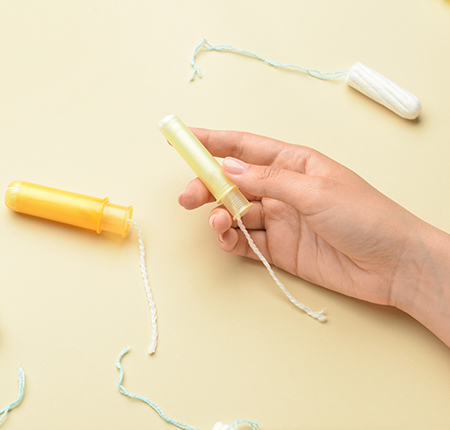
The tampon is one of the most convenient menstrual products on the market, but if you're new to your period, the thought of using internal tampons can be intimidating! However, tampons are safe and a very popular product for menstrual blood because they offer more freedom of movement. You just have to understand how they work and get comfortable with using them!
What are tampons?
Tampons are small cotton devices that are inserted into the vagina and absorb menstrual blood. Some tampons come with an applicator that can help you insert it, others are without an applicator. Tampons usually have a string attached to the end so you can easily remove them.
When did the first tampons appear?
The advantages of tampons have been recognized for centuries: the ancient Egyptians were the first to use tampons! These were made of softened papyrus. In ancient Rome, women made their own tampons from wool and in Indonesia, they were made from plant fibers or grass.
What are tampons made of?
Today, FDA-approved tampons are made of cotton, rayon, or a blend of the two. The absorbent fibers used in commercial tampons today are manufactured using an elemental chlorine-free bleaching process, which prevents the products from having dangerous levels of dioxin (a type of pollutant found in the environment).
In general, tampons have several parts:
A plunger applicator
The blood absorbent pad
A string for removal

Not all tampons come with an applicator. Instead, they are all meant to be disposable, meaning they are thrown away after use. Applicators can be made of cardboard or plastic.
How do I choose the right size of a tampon?
Tampons are available in a variety of absorbency levels, from mini to super . Whether you choose light, normal or super, the size indicates the level of absorbency, and when choosing a tampon size, make sure you always choose the lowest absorbency necessary for your menstrual flow that day.
So there are several sizes to choose from and it may take some trial and error to find the right size. The important thing to know is that the right size is the one that absorbs the flow without leaving leaks and at the same time, that you can't feel inside. However, when you feel the tampon, it may not be inserted far enough.
Flow can vary greatly between the first and last day of your period, so it is recommended to have several sizes, just in case.
Types of tampons
Mini tampons are suitable on days with light menstrual flow, for example at the beginning or end of the period.
Normal tampons are suitable for light to medium flow.
Super tampons are suitable for heavy flow.
Today you can find tampons with or without an applicator on the market.
What is Toxic Shock Syndrome?
Although associated with menstrual tampon use, Toxic Shock Syndrome can affect anyone of any age and gender. Symptoms appear suddenly and evolve quickly: when diagnosed, it must be treated immediately because it is a serious condition that can be life-threatening.
People who use tampons during menstruation are more likely to develop this syndrome, and although the mechanisms are not fully understood they may be related to the presence of highly toxic ingredients that act as hormone disruptors. But you can read our article dedicated to this topic to find out more!
How to use tampons safely
The first few times you use a tampon can be awkward, but if placed correctly, the tampon provides comfort and safety.
How to insert a tampon
If you're using a tampon without an applicator (and less plastic, easier to carry) start by washing your hands and checking that the tampon is completely sealed.
Remove and discard the packaging according to the instructions on the packaging and untie the tampon. Place your index finger at the bottom of the pad and hold the sides with your thumb and middle finger. Whether you're sitting (on the toilet) or standing up, remember to relax and breathe. With your free hand, you can hold the vaginal entrance slightly open.
Then, insert the pad the full length of your index finger, gently, aiming for the lower back. When the pad is in place, you won't feel it at all. And if you feel it, push it in a little more. Leave the cord hanging off your body and wash your hands.
How do I know I inserted the tampon correctly?
If the tampon is used correctly, you shouldn't feel it at all. If it is not inserted correctly, then you will feel discomfort or even pain. So always make sure you insert it at the right angle and push it in far enough.
What do I do with the wire that is left out?
The thread of the tampon is essential to be able to remove it, when necessary. You can let it hang out without any problem. Do not insert it into the vagina.
How to remove a tampon
Ok, it's time to remove the tampon. how do you do that First, relax your pelvic muscles and body. You can sit on the toilet or stand, propped up on one leg, if that's easier for you. Removal is simple: just pull the pad string.
What is the difference between regular and organic tampons?
If you were wondering what the difference is between regular cotton tampons and 100% organic cotton tampons, well, there are more!
Most of the time, we don't wonder what a tampon is made of. Those who search, however, know that regular tampons can contain toxic ingredients, easily absorbed into the bloodstream, endocrine disruptors, fragrances and pesticides. Yes, it sounds pretty scary… Rightfully so! But have you ever wondered why ingredients are important?
Your vagina is extremely absorbent, and in direct contact with these ingredients, the risks for:
Hormonal imbalance
Thyroid diseases
Irritations and allergies
Various infections
Menorrhagia
Endometriosis
Diabetes
Chemicals, plastic, and toxins in most menstrual products, including tampons, cause vaginitis, bacterial vaginosis, and infections.

Gynecologists recommend organic cotton tampons without fragrance, chlorine or dyes. And the good news is that ENROUSH tampons contain only one ingredient: 100% organic cotton, GOTS certified. They are free of plastic, fragrance, chlorine, pesticides, GMOs and other toxins.
ENROUSH organic tampons are made of 100% organic cotton, which has no side effects on health or the environment. In the cultivation of organic cotton, no pesticides are used and agriculture is sustainable, in favor of natural resources and biodiversity.
Myths about tampons
A tampon can get lost or stuck in your body
False. A tampon cannot get lost inside you! Once you insert the pad and until you remove it, it stays in place. It can't go through your cervix and it can't get lost inside you. Furthermore, the tampon cannot reach the uterus because the opening of the cervix is too small for a tampon. But if you have difficulty removing a tampon, for various reasons, do not hesitate to consult an emergency doctor.
Pads don't get stuck! If you feel it doesn't move when you pull, it's most likely not full yet or your vaginal muscles are too tight. When you want to remove it, it's important to relax.
It is not good to use tampons during the night
False. A tampon can also be worn during the night and you can sleep wearing one without any problem. But the general recommendation is not to wear a tampon for more than 8 hours - ideally between 4 - 6 hours. You just have to make sure you change your tampon right before you go to bed and right after you wake up! And if you plan to sleep more in the morning, choose an organic overnight absorbent instead.
A pad that's too small doesn't give me protection
False. Because more absorption power is not always the best choice! Why? High absorbency tampons are intended exclusively for days when you have a heavy flow. But if this is not the case, it is recommended to use tampons with lower absorption and change them regularly.
Plus, regardless of size, the 100% organic cotton pad fibers are highly absorbent, with absorbency evenly distributed. It will hold menstrual blood until you change it, and when choosing your size, remember to find the right level of absorbency based on your menstrual flow. If it's your first time using a tampon, choose the ENROUSH Mini because it will be the easiest to insert, but if the bleeding is moderate or heavy, choose the ENROUSH normal.
You have to change the tampon every time you go to the toilet
No, you don't have to! Although you may feel discomfort, it is not necessary to remove it every time you go to the toilet: the vagina, urethra and intestines are separate organs, each with its own opening. So, you choose.
Tampons become virgin and cannot be used during the first period
False. You can use tampons when you have your first period, or menarche. The hymen is elastic and is perforated or only partially covers the vagina to allow menstrual blood to pass. So a tampon cannot "virginize". But more than that, virginity is a social concept and not a thing (more precisely a foreskin) that you "lose" - and I wrote more about virginity in this article !
Tampons increase the risk of cancer
False. Tampons cannot increase the risk of cervical cancer, because it is caused, in over 90% of cases, by the HPV virus. However, using a tampon incorrectly, using tampons that contain dioxin, fragrance, chlorine and hidden substances, or using a tampon for a longer period of time can increase the risk of Toxic Shock Syndrome. But as long as you use them correctly and choose only one ingredient - 100% organic, certified cotton - you have nothing to worry about.
It is dangerous to wear a tampon for more than 4 hours
False. Internal tampons can be worn for up to 8 hours and it all depends on your flow. Usually, a tampon is normally changed every 3 to 6 hours for medium or heavy flow, and a mini tampon for low flow, once every 6-8 hours.
So the flow is the only thing that determines when you need to change the tampon. How do you check that it needs to be changed? Simple! You can easily pull the tampon thread, and if it moves easily, it means it is full enough. If it doesn't move, it's not saturated enough yet and you can leave it.
























